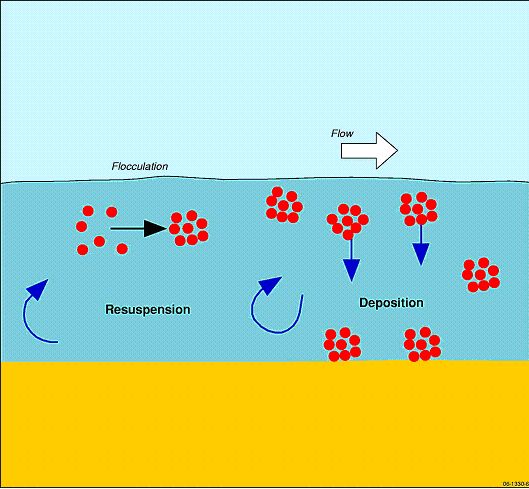Flocculation
Flocculation in coastal waterways is a process in which particles of clay and organic matter stick together, through chemical interactions with divalent calcium and magnesium ions, to form larger flake-like particles (flocs or floccules) that may come out of solution. Flocculation influences the transport of fine-grained sediment, and enhances its deposition rate [1]. Because particles belonging to various size classes can form flocs, the sediment that is deposited is often poorly sorted [2]. Flocculation contributes to the formation of a turbidity maximum in coastal waterways (Figure 1), and can also cause patches of nutrients to form on the seabed, providing food for micro-organisms.

Figure 1. Conceptual illustration of the flocculation process (modified from illustration in [4])
- Shanks, A. L. and Trent, J. D. (1980). Marine snow: sinking rates and potential role in vertical flux. Deep-Sea Res. Pt. A 27, 137-43.
- Kranck, K. and Milligan, T. G. (1983). Grain size distributions of inorganic suspended river sediment. In: Degens, E. T., Kempe, S. and Soliman, H. (Eds) Transport of Carbon and Minerals in Major World Rivers, Pt. 2. Mitt. Geol.-Paläont. Inst. Univ. Hamburg, SCOPE/UNEP Sonderbd. 55, pp. 525-34.
- Eisma, D. and Cadee, G.C. (2002). Particulate Matter in Estuaries, In SCOPE 42 – Biogeochemistry of Major World Rivers, accessed November.
- Webster, I.T., Ford, P.W., Robson, B., Margvelashvili, N., and Parslow, J.S. 2003. Conceptual Models of the Hydrodynamics, Fine-Sediment Dynamics, Biogeochemistry, and Primary Production in the Fitzroy Estuary. Cooperative Research Centre for Coastal Zone, Estuary & Waterway Management Technical Report #8.


